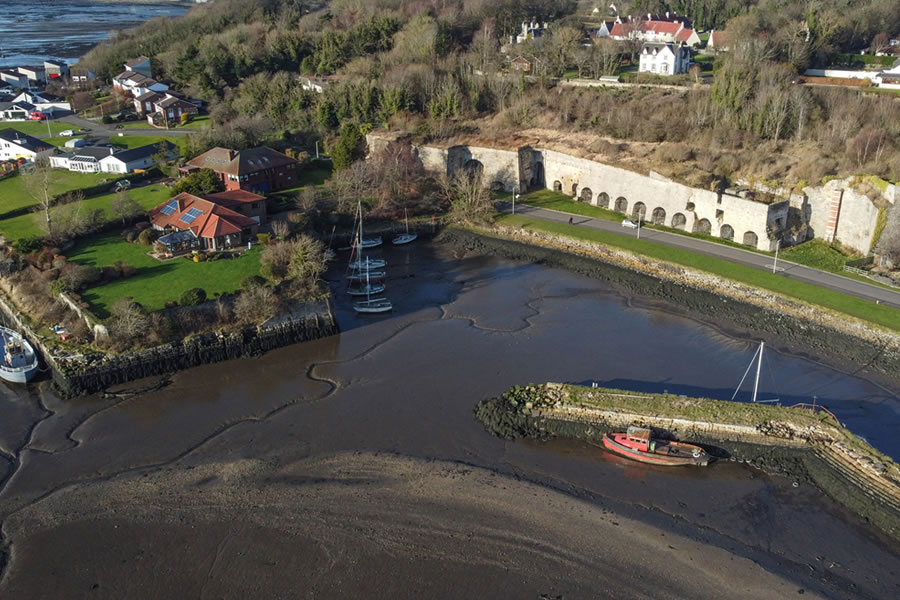Industry
West Fife’s industrial origins
Coal mining was the first major industrial activity to be recorded in West Fife. The monks of the Abbey of Dunfermline were recorded as digging for coal as early 1291, and innovative techniques were employed at Culross from the 1610s, by the local landowner, George Bruce of Carnock. In the late eighteenth century new technology allowed for the exploitation of the coal and ironstone deposits in the region on an industrial scale, with wagonways taking the product to harbours like St David’s, Inverkeithing, Limekilns and Charlestown. Coal mining was boosted by further investment in the first half of the twentieth century, and West Fife remained heavily dependent on the industry well into 1960s and 1970s, with the Valleyfield pit the last in the region to close in 1978. The legacy of this industry, including Miners Institutes in Steelend, Valleyfield and Oakley, can still be seen across the region.

The textile industry
From the 18th century, West Fife was also associated textile production. Using centuries old trading connections with the Baltic to import the raw flax upon which the textile industry was based, the production of linen began with handlooms in people’s own homes, before being replaced in the mid-19th century by the factory system, putting handloom weavers like Andrew Carnegie’s father out of work. The tall chimneys of a series of steam powered mills dominated Dunfermline’s skyline, and produced the famous damask table linen, and silk that were the town’s hallmark. Other key local industries were salt production, with Culross and Kincardine major centres in the 17th century, and pans found at Inverkeithing and Limekilns in the 18th century. Quarrying was also a major employer in West Fife, with sandstone, ironstone, whinstone, and limestone dug at various sites, with production of the latter being particularly important in Limekilns and Charlestown.
The paper industry
The paper industry first developed in the region in the early 19th century, centred in West Fife on mills in Inverkeithing and Dunfermline, with the last sites shutting in the 1990s. In addition to these large-scale industries, West Fife has seen countless other smaller scale or short-lived attempts at brewing, distilling, ship building and breaking, rope production, tanning among other industries, taking place across the region from the 18th century onwards.
Further Reading
• Donald Omand, (ed) The Fife book (Edinburgh: Birlinn), chapter 17
• Guthie Hutton, Fife: the mining kingdom (Ochiltree, Stenlake, 1999)
5 ways to improve your wellbeing through heritage
Keep Learning at Townhill Mining Heritage Garden
This garden is located within Townhill Park. It is dedicated to the men, women and children who worked and, in some cases, died in the collieries of Townhill. More information.
Be Active and explore the West Fife Woodland’s Way
This 16km circular trail around a network of paths in West Fife takes you through the old grounds of a country estate, a reclaimed indutrial landscape, water meadows, ancient woodland and the village of Culross. There are impressive views of the Ochil and Pentland hills. You can walk and learn more with this free audio tour for the West Fife Woodland’s Way.
Connect with others at Kincardine Local History Group
Established in 1978 and online since 1997. This non-profit community-run organisation aims to research, preserve, and promote the history of Kincardine-on-Forth. Meetings are held once a month from October to March and feature talks on various aspects of local and not-so-local history. All welcome to attend the meetings which are held in the Community Centre, Anderson Lane, Kincardine. More information.
Take Notice at Valleyfield Estate
The carpet of snowdrops in the Valleyfield woodland park are a beautiful sight in February and March, and later in the year the vast display of native bluebells are spectacular. Perfect for a slow walk or just sitting and enjoying.

Give your time to help restore local woodlands
West Fife Woodlands group was created to restore, revive and protect the woodland areas around West Fife. They are involved in a range of projects maintaning and developing routes and paths. Find out more on their Facebook page
